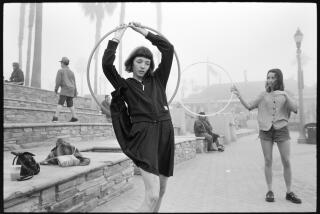Discovering ‘Black Mexico’ : Photography: Tony Gleaton’s exhibit in San Juan Capistrano gives viewers an intimate look into villagers’ daily lives and rituals.
- Share via
“I love the ‘other’ ... those who are separated from any dominant cultural group. My work examines our common elements and the disparities which, in making us different, also bind us together in the human condition. My photographs are a metaphor for a state of grace which lies within us.” --Photographer Tony Gleaton
When Tony Gleaton returned from Vietnam in the 1960s, he pursued a career in photography that eventually led him to New York City and his fashion layouts onto the pages of Vogue magazine in Great Britain. But the former Marine sergeant grew tired of the fashion scene and began a series exploring the American West from a black perspective.
“That was the beginning of a whole new phase in my life and an awakening for me as a black American,” said Gleaton. “Black and Native American cowboys don’t fit the John Wayne image, so history and the mythic tales of the American West never included them,” he said. “Whoever is paying the storyteller gets their story told.”
Gleaton’s work on the series took a lucky turn when he heard that small enclaves of blacks inhabited the Costa Chica region of Mexico and that they were descendants of blacks who had lived there for centuries.
He set out to find them, hitching rides and traveling by bus to an area three hours south of Acapulco. “When I got there, I found a people without a common mythology,” he said. “Every village had a different tale of how their ancestors arrived in Mexico. I thought it was interesting that the early presence of blacks in the Americas was rarely discussed and largely undocumented,” he said.
Gleaton’s subsequent trips and monthlong stays with the villagers culminated in the exhibition “Mexico Negro: El Legado Africano (Black Mexico: The African Legacy),” which opens today at the San Juan Capistrano Regional Library. Gleaton’s 40-photograph series gives the viewer a respectful and intimate look into villagers’ daily lives and rituals. The marketplace, barbershop and pool hall are all documented as well as funerals, weddings and children at play.
“Each of Gleaton’s subjects possess an unself-conscious beauty and dignity,” said library director Jose Aponte, who arranged for the nationally touring exhibit to stop in San Juan.
Gleaton’s work is included in many national and international collections, including the famous Schomburg Collection of the New York Public Library, one of the premier holdings on black culture in the United States.
“Gleaton’s subjects have been glossed over in Mexican history,” said Bill Mason, curator of general Americana at the Natural History Museum in Los Angeles. “They are oddballs, since they are no longer African in outlook and culture and don’t fit the mestizo perception either,” Mason said. “They speak Spanish and some Indian dialects. They have been Mexicanized but aren’t typically Mexican.”
Anthropologists and historians disagree on how blacks came to live in Mexico. It is generally accepted that they were brought as slaves by the Spanish conquistadors, but some evidence suggests they were present in the pre-Columbian era.
“Either way, they have survived, and Gleaton’s work is important to understanding” the dispersion of black populations throughout the world, Mason said.
“Mexico Negro: El Legado Africano (Black Mexico: The African Legacy),” a photographic exhibition by Tony Gleaton, is on display today through Oct. 31. Reception today, 6 to 11 p.m., at San Juan Capistrano Regional Library, 31495 El Camino Real, San Juan Capistrano. (714) 493-1752.
More to Read
The biggest entertainment stories
Get our big stories about Hollywood, film, television, music, arts, culture and more right in your inbox as soon as they publish.
You may occasionally receive promotional content from the Los Angeles Times.










